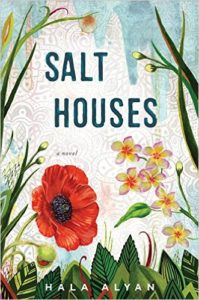
Most Americans have a simplistic idea of Arab cultures and the variety of experiences within them. We seem to assume that every Arab is religious; that every Arab woman wears the veil, and that it is forced on her; that women have little freedom to be educated, think for themselves, or travel. Hala Alyan’s debut novel, Salt Houses, serves as a small corrective to that generalized picture—“small” only because we need many more stories like this one to stand a chance against the prevailing narrative.
Salt Houses follows the Yacoub family over roughly fifty years. This gentle telling of a raucous history—jostled by its many personalities and much geopolitical discord—begins in March of 1963 with the family’s matriarch, Salma, in Nablus, a city in the area presently known as the West Bank. When the book begins, Hussam, Salma’s husband and the Yacoub patriarch, has died. Alone, Salma converses internally with Hussam about what troubles her—their daughter Alia’s refusal of the veil; the mis-ordered marriages of her children (Alia, the youngest, before her older brother, Mustafa); the camps of displaced Palestinians, and her family’s “armor of wealth,” which saved them from that life; and the changing roles of women in society, which she witnesses through her children.
Each new chapter of Salt Houses shifts perspective and jumps in time. From Salma, we go to Mustafa in 1965, still in Nablus, and then to Alia in 1967 in Kuwait City. The book moves forward in time and across space, reaching all the way to Salma’s pregnant great-granddaughter Manar in 2014, in Jaffa. These perspectives touch back on each other through small details, fashioning a collective, familial history. One character’s revelations illuminate the life of another.
Alia clothes herself as she pleases, preferring “tight dresses” in defiance of the verse her father would have quoted, had he been alive to see, “And say to the believing women that they should lower their gaze and guard their modesty.” It’s not clear whether Alia believes. Salma overhears Alia speculate that “Allah might be the most useful invention of all.” She is irreverent and stormy, often yelling, often hungry, always thinking.
Alyan’s talent is immediately apparent in her exquisitely detailed scenes and the complex ways her characters relate to one another. Alia and Mustafa have an older sister, Widad, living in Kuwait with her husband. Alia sees Widad as “sluggish and melancholy and resigned to her life, its tasks of folding sheets, overseeing… dusting, spending hours preparing dinner.” During Alia’s visit to Widad, which was supposed to last a month, the Six-Day War begins and ends. Mustafa does not survive. The family is grief-stricken, but there’s a moment of joy as Alia and Widad dance together at a party:
Their feet are bare, and the blue Persian rugs are soft beneath them. The other women dance around them, the air rippling with dozens of perfumes. The lights are dimmed, candles in silver candelabras casting shadows across the walls.
A moment later, Alia examines her sister’s face, “the lashes coated in mascara, the reddening from her eyebrow threading this morning” and “impulsively… kisses her cheek.” This is the way of the book: relationships wane and build and wane again, as family members are born, move, leave for college, get married, have children, die.
The character we see from beginning to end is Alia. We witness her marriage to Atef in the garden of her mother’s Nablus home; the births of her three children, and their marriages, the births of their children, her grandchildren. Alia is sharp, a bit foul-mouthed, moody. She longs to live in the Amman of her childhood, but Atef has a teaching job in Kuwait. She does not understand the religious devotion of her sister, Widad, or her daughter, Riham, but she doesn’t condemn them, either.
Salt Houses offers many rebuttals to the conventional rendering of Arab life. The most prominent man in the book, Atef, is not religious. But when his grandson, Abdullah, brings radical ideas home, the family’s fear is palpable. This is not who they are, not who he is, but growing up around war and poverty and pain has an effect. Atef’s intellectualism cannot save Abdullah, but the love of Abdullah’s mother, Riham, does—the love of Allah that she and her son share.
This story carries so many voices as it rises and falls. Characters who go unmentioned for a few chapters resurface, outlying stories are braided into the central line. This rich history enables us to feel each family member’s unique emotions.
Alyan is also a poet, and the last pages of Salt Houses drop like the end of a poem—they crush the reader while also lifting her up. Alia has grown old, but the efforts of her life are evident in the constant gathering of family around her. She has invested in them, and they in each other. In grief over his ailing wife, Atef slips out of his full house, into his garden, and begins to uproot the flowers there. His grandchildren come out to check on him. They kneel to help as he tells them of the many places he and Alia lived:
The houses float up to his mind’s eye like jinn, past lovers. The sloping roof of his mother’s hut, the marbled tiles in Salma’s kitchen, the small house he shared with Alia in Nablus. The Kuwait home. The Beirut apartments. This house, here in Amman… They glitter whitely in his mind, like structures made of salt, before a tidal wave comes and sweeps them away.
Narratives like this one complicate and humanize America’s simplistic view of Arab cultures, toppling the flimsy idea that Arab people are intractably Other.




